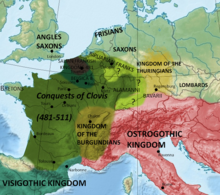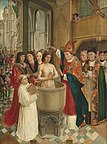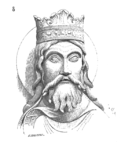Clovis I
Jump to navigationJump to search
| Clovis I | |
|---|---|

Baptism of Clovis, ivory book cover from c. 870
|
|
| King of the Franks | |
| Reign | c. 509 – 27 November 511 |
| King of the Salian Franks | |
| Reign | 481 – c. 509 |
| Predecessor | Childeric I |
| Born | c. 466 Tournai, Roman Empire (present-day Belgium) |
| Died | 27 November 511 (aged about 45) Paris, Francia |
| Burial |
Originally St. Genevieve Church; now Saint-Denis Basilica
|
| Spouse | Clotilde |
| Issue | |
| Dynasty | Merovingian |
| Father | Childeric I |
| Mother | Basina of Thuringia |
| Religion | Initially Frankish paganism, but converted to Chalcedonian Christianity |
Clovis (Latin: Chlodovechus; reconstructed Frankish: *Hlodowig; c. 466 – 27 November 511)[1] was the first king of the Franks to unite all of the Frankish tribes under one ruler, changing the form of leadership from a group of royal chieftains to rule by a single king and ensuring that the kingship was passed down to his heirs.[2] He is considered to have been the founder of the Merovingian dynasty, which ruled the Frankish kingdom for the next two centuries.
Clovis succeeded his father, Childeric I, as a king of Salian Franks within the Roman empire in 481, and eventually came to rule an area extending from what is now the southern Netherlands to northern France, corresponding in Roman terms to Gallia Belgica (northern Gaul). At the Battle of Soissons (486) he established his military dominance of the rump state of the fragmenting Western Roman Empire which was then under the command of Syagrius. By the time of his death in either 511 or 513, Clovis had conquered several smaller Frankish tribes in the northeast of Gaul or modern day France. Clovis also conquered the Alemanni tribes in eastern Gaul, and the Visigothic kingdom of Aquitania in the southwest. These campaigns had added significantly to Clovis’s domains, and established his dynasty as a major political and military presence in western europe.
Clovis is important in the historiography of France as “the first king of what would become France”.[3]
Clovis is also significant due to his conversion to Catholicism in 496, largely at the behest of his wife, Clotilde, who would later be venerated as a saint for this act, celebrated today in both the Roman Catholic Church and Eastern Orthodox Church. Clovis was baptized on Christmas Day in 508.[4] The adoption by Clovis of Catholicism (as opposed to the Arianism of most other Germanic tribes) led to widespread conversion among the Frankish peoples; to religious unification across what is now modern-day France, Belgium and Germany; three centuries later, to Charlemagne‘s alliance with the Bishop of Rome; and in the middle of the 10th century under Otto I the Great, to the consequent birth of the early Holy Roman Empire.
Name
Based on the attested forms, the original name is reconstructed in the Frankish language as *Hlodowig, which means ‘glorious in battle’ or ‘glorious warrior’. It is composed of the root hlod- (“fame, glory”) attached to –wig (“combat, battle”).[5][6]
In Middle Dutch, a Franconian language closely related to Frankish, the name was rendered as Lodewijch (cf. modern Dutch Lodewijk and Lowik).[7][8] The name is found in other West Germanic languages, with cognates including Old English Hloðwig, Old Saxon Hluduco, and Old High German Hludwīg (variant Hluotwīg).[5] The latter turned into Ludwig in Modern German, although the king Clovis himself is generally named Chlodwig.[8] The Old Norse form Hlǫðvér was most likely borrowed from a West Germanic language.[5]
The Frankish name *Hlodowig is at the origin of the French given name Louis (variant Ludovic), borne by 18 kings of France, via the Latinized form Hludovicus (variants Ludhovicus, Lodhuvicus, or Chlodovicus).[6] The English Lewis stems from the Anglo-French Louis.[9] In Spanish, the name became Luis, in Italian Luigi (variant Ludovico), and in Hungarian Lajos.[8]
Background
Clovis was the son of Childeric I, a Merovingian king of the Salian Franks, and Basina, a Thuringian princess. It was his supposed ancestor, Merovich, for which his Merovingian dynasty is named. Clovis succeeded his father to become king at the age of 15 in 481, as deduced from Gregory of Tours placing the Battle of Tolbiac (Zülpich) in the fifteenth year of Clovis’s reign.
Numerous small Frankish petty kingdoms existed during the 5th century. The Salian Franks were the first known Frankish tribe that settled with official Roman permission within the empire, first in Batavia in the Rhine-Maas delta, and then in 375 in Toxandria, roughly the current province of North Brabant in the Netherlands and parts of neighbouring Belgian provinces of Antwerp and Limburg in current Belgium. This put them in the north part of the Roman civitas Tungrorum, with Romanized population still dominant south of the military highway Boulogne-Cologne. Later, Chlodio seems to have attacked westwards from this area to take control of the Roman populations in Tournai, then southwards to Artois, and Cambrai, eventually controlling an area stretching to the Somme river.
Childeric I, Clovis’s father, was reputed to be a relative of Chlodio, and was known as the king of the Franks that fought as an army within northern Gaul. In 463 he fought in conjunction with Aegidius, the magister militum of northern Gaul, to defeat the Visigoths in Orléans. Childeric died in 481 and was buried in Tournai; Clovis succeeded him as king, aged just 15. Historians believe that Childeric and Clovis were both commanders of the Roman military in the Province of Belgica Secunda and were subordinate to the magister militum.[10] The Franks of Tournai came to dominate their neighbours, initially aided by the association with Aegidius.[11]
The death of Flavius Aetius in 454 led to the decline of imperial power in the Gaul; leaving the Visigoths and the Burgundians compete for predominance in the area. The part of Gaul still under Roman control emerged as a kingdom under Syagrius, Aegidius’ son.[12]
Early reign (481–491)
Road to Soissons
The ruler of Tournai died in 481 and was succeeded by his sixteen-year-old son, Clovis. His band of warriors probably numbered no more than half a thousand. In 486 he began his efforts to expand the realm by allying himself with his relative, Ragnachar, regulus of Cambrai[13] and another Frankish regulus, Chalaric. Together the triumvirate marched against Syagrius and met the Gallo-Roman commander at Soissons. During the battle Chalaric betrayed his comrades by refusing to take part in the fighting.[14] Despite the betrayal, the Franks landed a decisive victory, forcing Syagrius to flee to the court of Alaric II.[13] This battle is viewed as bringing about the end of the rump state of the Western Roman Empire outside of Italy.[15] Following the battle, Clovis invaded the traitor Chararic’s territory and was able to imprison him and his son.[14]
Taming Gaul
Prior to the battle, Clovis did not enjoy the support of the Gallo-Roman clergy, hence he proceeded to pillage the Roman territory, including the churches. The Bishop of Reims requested Clovis return everything taken from the Church of Reims, and, as the young king aspired to establish cordial relationships with the clergy, he returned a valuable ewer taken from the church.[16] Despite his position, some Roman cities refused to yield to the Franks, namely Verdun‒which surrendered after a brief siege‒and Paris, which stubbornly resisted a few years, perhaps as many as five.[13] He made Paris his capital[17] and established an abbey dedicated to Saints Peter and Paul on the south bank of the Seine.[18]
Clovis came to the realisation that he wouldn’t be able to rule Gaul without the help of the clergy and aimed to please the clergy by taking a Catholic wife.[16] He also integrated many of Syagrius’ units into his own army. The Roman kingdom was probably under Clovis’ control by 491, because in the same year Clovis successfully moved against a small number of Thuringians in the eastern Gaul, near the Burgundian border.[19]
Middle reign (492–506)
Barbarian bonding
Around 493 AD, he secured an alliance with the Ostrogoths through the marriage of his sister Audofleda to their king, Theodoric the Great.[17] In the same year, the neighboring King of the Burgundians was slain by his brother, Gundobad; bringing civil strife to that kingdom. He proceeded to drown his sister-in-law and force his niece, Chrona, into a convent; another niece, Clotilde, fled to the court of her other uncle. Finding himself in a precarious position this uncle, Godegisel, decided to ally himself to Clovis by marrying his exiled niece to the Frankish king.[20]
Assault of the Alamanni
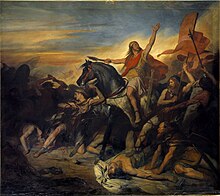
Clovis I leading the Franks to victory in the Battle of Tolbiac, in Ary Scheffer‘s 1836 painting
In 496 the Alamanni invaded, some Salians and Ripuarians reguli defected to their side. Clovis met his enemies near the strong fort of Tolbiac. During the fighting, the Franks suffered heavy losses and Clovis (+three thousand Frankish companions) might have converted to Christianity.[21] With the help of the Ripuarian Franks he narrowly defeated the Alamanni in the Battle of Tolbiac in 496.[17] Now Christian, Clovis confined his prisoners, Chararic and his son to a monastery.[14]
Business in Burgundy
In 500 or 501 the relationship between the Burgundian brothers took the turn to the worse began scheming against his brother. He promised his brother-in-law territory and annual tribute for defeating his brother. He seduced his brother-in-law with the promises of territory and annual tribute for deposing his brother; Clovis was eager to subdue the political threat to his realm and crossed to the Burgundian territory. After hearing about the incident Gundobad moved against Clovis and called his brother. The three armies met near Dijon, where both the Franks and Godegisel’s forces defeated the host of dumbfounded Gundobad, who was able to escape to Avignon. Clovis proceeded to follow to the Burgundian king and laid siege to the city, however, after some months he was convinced to abandon the siege and settled for an annual tributary from Gundobad.[22]
Armonici allies
In 501, 502 or 503 Clovis led his troops to Armorica. He had previously restricted his operations to minor raids, yet, this time the goal was subjugation. Clovis’ failed to complete his objective via military means, therefore, he was constrained to statecraft, which proved fruitful for the Armonici shared Clovis’ disdain for the Arian Visigoths. And thus Armorica and her fighters were integrated into Frankish realm.[23]
Late reign (507–511)
Visiting the Visigoths
In 507 Clovis was allowed by the magnates of his realm to invade the remaining threat of the Kingdom of the Visigoths.[24] King Alaric had previously tried to establish a cordial relationship with Clovis by serving him the head of exiled Syagrius on a silver plate in 486 or 487.[13] However, Clovis was no longer able to resist the temptation to move against the Visigoths for many Catholics under Visigoth yoke were unhappy and implored Clovis to make a move. [25] But just to be absolutely certain about retaining the loyalties of the Catholics under Visigoths, Clovis ordered his troops to omit raiding and plunder, for this was not a foreign invasion, but a liberation.[24]
Armonici assisted him in defeating the Visigothic kingdom of Toulouse in the Battle of Vouillé in 507, eliminating Visigothic power in Gaul. The battle added most of Aquitaine to Clovis’s kingdom[17] and resulted in the death of the Visigothic king Alaric II.
According to Gregory of Tours, following the battle, the Byzantine Emperor Anastasius I granted Clovis the title of consul. Since Clovis’s name does not appear in the consular lists, it is likely he was granted a suffect consulship.[citation needed]
Ravishing the Reguli
In 507, following Vouillé, Clovis heard about Chararic’s plan to escape from his monastic prison and had him murdered.[14]
In the same year, Clovis convinced Prince Chlodoric to murder his father, earning him his nickname. Following the murder, Clovis betrayed Chlodoric and had his envoys strike him down. [26]
In 509, Clovis visited his old ally, Ragnachar in Cambrai. Following his conversion, many of his pagan retainers had defected to Ragnachar’s side, making him a political threat. Ragnachar denied Clovis’s entry, prompting Clovis to make a move against him. He bribed Ragnachar’s retainers and soon, Ragnachar and his brother, Ricchar were captured and executed.[27]
Death

The partition of the Frankish kingdom among the four sons of Clovis with Clotilde presiding, Grandes Chroniques de Saint-Denis (Bibliothèque municipale de Toulouse)
Shortly before his death, Clovis called a synod of Gallic bishops to meet in Orléans to reform the Church and create a strong link between the Crown and the Catholic episcopate. This was the First Council of Orléans. Thirty-three bishops assisted and passed 31 decrees on the duties and obligations of individuals, the right of sanctuary, and ecclesiastical discipline. These decrees, equally applicable to Franks and Romans, first established equality between conquerors and conquered.
Clovis I is traditionally said to have died on 27 November 511; however, the Liber Pontificalis suggests that he was still alive in 513, so the exact date of his death is not known.[28] After his death, Clovis was laid to rest in the Abbey of St Genevieve in Paris. His remains were relocated to Saint Denis Basilica in the mid- to late-18th century.
When Clovis died, his kingdom was partitioned among his four sons, Theuderic, Chlodomer, Childebert, and Clotaire. This partition created the new political units of the Kingdoms of Rheims, Orléans, Paris and Soissons, and inaugurated a tradition that would lead to disunity lasting until the end of the Merovingian dynasty in 751. Clovis had been a king with no fixed capital and no central administration beyond his entourage. By deciding to be interred at Paris, Clovis gave the city symbolic weight. When his grandchildren divided royal power 50 years after his death in 511, Paris was kept as a joint property and a fixed symbol of the dynasty.[29]
The disunity continued under the Carolingians until, after a brief unity under Charlemagne, the Franks splintered into distinct spheres of cultural influence that coalesced around Eastern and Western centers of royal power. These later political, linguistic, and cultural entities became the Kingdom of France, the myriad German States, and the semi-autonomous kingdoms of Burgundy and Lotharingia.
Baptism

Tomb of Clovis I at the Basilica of St Denis in Saint Denis
Clovis was born a pagan but later became interested in converting to Arian Christianity, whose followers believed that Jesus was a distinct and separate being from God the Father, both subordinate to and created by Him. This contrasted Nicene Christianity, whose followers believe that God the Father, Jesus, and the Holy Spirit are three persons of one being (consubstantiality). While the theology of the Arians was declared a heresy at the First Council of Nicea in 325, the missionary work of Bishop Ulfilas converted the pagan Goths to Arian Christianity in the 4th century. By the time of the ascension of Clovis, Gothic Arians dominated Christian Gaul, and Catholics were in the minority.
Clovis’s wife Clotilde, a Burgundian princess, was a Catholic despite the Arianism that surrounded her at court.[30] Her persistence eventually persuaded Clovis to convert to Catholicism, which he initially resisted. Clotilde had wanted her son to be baptized, but Clovis refused, so she had the child baptized without Clovis’s knowledge. Shortly after his baptism, their son died, which further strengthened Clovis’s resistance to conversion. Clotilde also had their second son baptized without her husband’s permission, and this son became ill and nearly died after his baptism.[31] Clovis eventually converted to Catholicism following the Battle of Tolbiac on Christmas Day 508[32][33] in a small church in the vicinity of the subsequent Abbey of Saint-Remi in Reims; a statue of his baptism by Saint Remigius can still be seen there. The details of this event have been passed down by Gregory of Tours, who recorded them many years later in the 6th century.
The king’s Catholic baptism was of immense importance in the subsequent history of Western and Central Europe in general, as Clovis expanded his dominion over almost all of Gaul. Catholicism offered certain advantages to Clovis as he fought to distinguish his rule among many competing power centers in Western Europe. His conversion to the Roman Catholic form of Christianity served to set him apart from the other Germanic kings of his time, such as those of the Visigoths and the Vandals, who had converted from Germanic paganism to Arian Christianity. His embrace of the Roman Catholic faith may have also gained him the support of the Catholic Gallo-Roman aristocracy in his later campaign against the Visigoths, which drove them from southern Gaul in 507 and resulted in a great many of his people converting to Catholicism as well.[34]
On the other hand, Bernard Bachrach has argued that his conversion from Frankish paganism alienated many of the other Frankish sub-kings and weakened his military position over the next few years. In the interpretatio romana, Saint Gregory of Tours gave the Germanic gods that Clovis abandoned the names of roughly equivalent Roman gods, such as Jupiter and Mercury.[35] William Daly, more directly assessing Clovis’s allegedly barbaric and pagan origins,[36] ignored the Gregory of Tours version and based his account on the scant earlier sources, a sixth-century “vita” of Saint Genevieve and letters to or concerning Clovis from bishops (now in the Epistolae Austrasicae) and Theodoric.
Clovis and his wife were buried in the Abbey of St Genevieve (St. Pierre) in Paris; the original name of the church was the Church of the Holy Apostles.[37]
Roman Law
Under Clovis, the first codification of the Salian Frank law took place. The Roman Law was written with the assistance of Gallo-Romans to reflect the Salic legal tradition and Christianity, while containing much from Roman tradition. The Roman Law lists various crimes as well as the fines associated with them.[38]
Legacy
The legacy of Clovis’s conquests, a Frankish kingdom that included most of Roman Gaul and parts of western Germany, survived long after his death.[39] To the French people, he is the founder of France.
Detracting, perhaps, from this legacy, is his aforementioned division of the state. This was done not along national or even largely geographical lines, but primarily to assure equal income amongst his sons after his death. While it may or may not have been his intention, this division was the cause of much internal discord in Gaul. This precedent led in the long run to the fall of his dynasty, for it was a pattern repeated in future reigns.[40] Clovis did bequeath to his heirs the support of both people and Church such that, when the magnates were ready to do away with the royal house, the sanction of the Pope was sought first.
By his conversion to Christianity he made himself the ally of the papacy and its protector as well as that of the people, who were mostly Catholics.
- Images of the King
-
Battle of Tolbiac. Fresco at the Panthéon (Paris) by Joseph Blanc, circa 1881.
-
Statue depicting the baptism of Clovis by Saint Remigius.
-
Clovis statue at the Abbey Church of Saint-Denis
-
The Sons of Clovis, by Georges Moreau de Tours (1877)
Sainthood
|
This section needs additional citations for verification. (September 2013) (Learn how and when to remove this template message)
|
|
King Saint Clovis
|
|
|---|---|
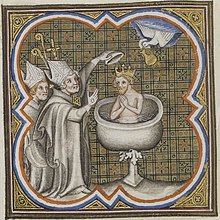 |
|
| King and New Constantine | |
| Born | c. 466 Tournai |
| Died | 27 November 511 Paris |
| Venerated in | Catholic Church in France |
| Major shrine | Basilica of Saint-Denis; Abbey of Saint Genevieve; Moissac Abbey |
| Feast | 27 November (France),[41]:497 26 October (South Italy)[42]:39 |
| Attributes | suit-of-armour; upright sword; fleur-de-lis; three frogs (his attributed arms) |
| Patronage | France[43]:25 |
| Controversy | Lack of papal approval; debated violent character; interference from the French state. |
In later centuries, Clovis was venerated as a saint in France. The Benedictine Abbey of Saint-Denis (where Clovis was buried) had a shrine to St. Clovis to the east of the main altar.[44]:34 There was also a shrine to him in the Abbey of Saint Genevieve in Paris.[45]:140 This shrine had a statue and a number of epitaphs and was probably where the veneration of St. Clovis began.[41]:497–502 Despite Clovis’ presence in Paris, his cultus was largely based in the south of France. Abbot Aymeric de Peyrat (d. 1406), the author of the History of the Moissac Abbey, claimed that his own monastery was founded by St. Clovis and there were many monasteries named in his honour.[46]:130 Aymeric not only referred to Clovis as a saint but also prayed for St. Clovis’ intercession.[46]:130 There were also known to be shrines dedicated to Clovis in Église Sainte-Marthe de Tarascon and Saint-Pierre-du-Dorât.[45]:140[47]:73 Boniface Symoneta, Jacques Almain and Paulus Aemilius Veronensis gave hagiographic accounts of Clovis’ life and at the time it was common to include Clovis’ life in collections of the lives of the saints.[47]:73
It has been suggested that the reason that the French state promoted the veneration of Clovis in the south was to establish a border cult that would cause Occitans to venerate the northern-led French state by venerating its founder.[47]:73 Another reason could be that Clovis was a preferable foundation figure for the House of Valois as their predecessors were the Direct Capetians who looked back to Charlemagne whose veneration had been widely recognised.[48]:140 In contrast to the theory of St. Clovis’ cult being a primarily northern-supported movement, Amy Goodrich Remensnyder suggests that St. Clovis was used by Occitans to reject the northern concept of the monarchy and to reinstate their autonomy as something granted by the saint.[46]:119–126
St. Clovis had the role of a more militarised royal saint than the pious Louis IX of France.[49]:297 As a saint, Clovis was important as he represented the spiritual birth of the nation and provided a chivalrous and ascetic political model for French political leaders to follow.[50]:54 The veneration of St. Clovis was not exclusive to France as a print by the Holy Roman woodcut designer Leonhard Beck made for the Habsburg monarchs depicts Clovis as St. Chlodoveus,[51] St. Boniface’s Abbey in Munich depicted St. Chlodoveus as a saint worthy of emulation because of his advocacy,[52]:239 and the Florentine Baroque painter Carlo Dolci painted a large depiction of St. Clovis for the Imperial Apartment in the Uffizi Gallery.[53]:106[54]:101
St. Clovis had no known official canonisation, neither was he beatified, so his sainthood was only ever recognised by popular acclaim.[50]:54 Following the example of the monks of St. Geneviève, St. Clovis’ feast day in France was held on 27 November.[41]:497 St. Clovis enjoyed a persistent campaign from French royal authorities that few non-French national or dynastic saints did.[49]:297 French monarchs, beginning in the Fourteenth Century at the latest, attempted to officially canonise Clovis a number of times.[55]:59 The most notable attempt. led by King Louis XI and modelled on the successful canonisation campaign of Louis IX, occurred during a conflict with the Burgundians.[56]:13 The cause for Clovis’ canonisation was taken up once again in the Seventeenth Century, with Jesuit support, a vita and an account of posthumous miracles, in opposition to the controversial historical works of Calvinist pastor Jean de Serres who portrayed Clovis as a cruel and bloodthirsty king.[55]:53–54, 59
Chronology
- c. 466: Clovis is born in Tournai.
- c. 467: Clovis’ sister, Audofleda is born.
- c. 468: Clovis’s sister, Lenteild is born.
- c. 470: Clovis’s sister Albofledis is born.
- c. 477: Clovis’s mother, Basina dies.
- c. 481: Clovis’s father, Childeric I dies and succeeded by Clovis.
- c. 486: Clovis defeats Syagrius in Soissons and begins the takeover of the kingdom.
- c. 487: Clovis’ son Theuderic I is born.
- c. 491: Clovis completes the conquest of the kingdom and turns his attention elsewhere.
- c. 493:
Clovis marries Audofleda to Theoderic the Great.
Clovis marries a Burgundian princess, Clotilde. - c. 494: Clovis’ and Clotilde’s first child, Ingomer is born and dies.
- c. 495.
Clovis’ and Clotilde’s second son, Chlodomer is born.
Clovis becomes an uncle as Audofleda gives birth to an Ostrogothic princess, Amalasuntha. - c. 496:
Clovis is baptised (early estimate).
Clovis defeats the Alamanni threat.
Clovis’ and Clotilde’s third son, Childebert I is born. - c. 497. Clovis’ and Clotilde’s fourth son, Chlothar I is born.
- c. 500:
Clovis subjugates Burgundy.
Clovis’ and Clotilde’s only daughter, Clotilde is born.
Albofledis dies. - c. 501: Clovis’ ally and brother-in-law, Godegisel is murdered.
- c. 502:
Clovis allies himself with the Armonici.
Theuderic marries Suavegotha. - c. 503: Clovis becomes a grandfather, when Theuderic secures a son of his own, Theudebert I.
- c. 507: Clovis liberates Aquitainia and murders various Frankish reguli.
- c. 508: Clovis baptized by the Bishop of Reims (late estimate).[57]
- c. 509:
Clovis executes the last pagan regulus.
Clovis is declared the king of all the Franks. - 511 November 27 or 513: Clovis dies in Paris
